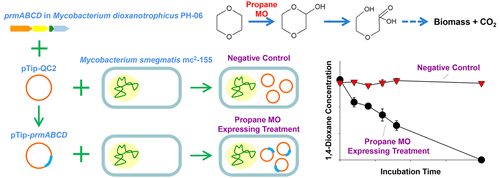当前位置:
X-MOL 学术
›
Environ. Sci. Technol. Lett.
›
论文详情
Our official English website, www.x-mol.net, welcomes your
feedback! (Note: you will need to create a separate account there.)
A Novel Propane Monooxygenase Initiating Degradation of 1,4-Dioxane by Mycobacterium dioxanotrophicus PH-06
Environmental Science & Technology Letters ( IF 8.9 ) Pub Date : 2017-12-11 00:00:00 , DOI: 10.1021/acs.estlett.7b00504 Daiyong Deng 1 , Fei Li 1 , Mengyan Li 1
Environmental Science & Technology Letters ( IF 8.9 ) Pub Date : 2017-12-11 00:00:00 , DOI: 10.1021/acs.estlett.7b00504 Daiyong Deng 1 , Fei Li 1 , Mengyan Li 1
Affiliation

|
Monitored natural attenuation and bioremediation are cost-efficient and eco-friendly approaches to mitigating prevalent 1,4-dioxane (dioxane) plumes. Unfortunately, their field applications have been greatly undermined given our scarce knowledge of the diversity of dioxane biodegradation pathways and associated key enzymes. At present, only tetrahydrofuran monooxygenases (THF MOs) are known to initiate dioxane degradation in dioxane metabolizers. In this study, we deciphered the essential catalytic role of a novel propane MO (encoded by the prmABCD gene cluster) in dioxane metabolism by Mycobacterium dioxanotrophicus PH-06. This propane MO is phylogenetically distinct from THF MOs on the basis of the low levels of amino acid sequence identity (<40% for α subunits). Reverse transcription polymerase chain reaction (RT-PCR) analysis revealed that the prmABCD gene cluster is an intact transcription unit that can be induced by dioxane, THF, or propane. In addition, the biotransformation activity of this propane MO toward dioxane, THF, and propane was confirmed using heterologous expression. Detection of 2-hydroxyethoxyacetic acid (HEAA) in the expression clones proves that this propane MO catalyzes dioxane decomposition via α-hydroxylation. This first enzymological identification of the propane MO in PH-06 expands our understanding of dioxane metabolic pathways and unequivocally enables the development of molecular tools for improving the assessment of natural attenuation and bioremediation at dioxane-impacted sites.
中文翻译:

一种新型的丙烷单加氧酶,由分枝杆菌PH-06降解1,4-二恶烷
监测到的自然衰减和生物修复是降低流行的1,4-二恶烷(dioxane)羽流的经济高效且环保的方法。不幸的是,由于我们对二恶烷生物降解途径和相关关键酶多样性的了解不足,极大地破坏了它们的现场应用。目前,已知只有四氢呋喃单加氧酶(THF MOs)引发二恶烷代谢物中的二恶烷降解。在这项研究中,我们破译了一种新的丙烷MO(由prmABCD基因簇编码)在由二氧甲烷分枝杆菌引起的二恶烷代谢中的重要催化作用。PH-06。基于低水平的氨基酸序列同一性(对于α亚基,<40%),该丙烷MO在分子系统发育上与THF MOs不同。逆转录聚合酶链反应(RT-PCR)分析显示prmABCD基因簇是一个完整的转录单位,可以被二恶烷,THF或丙烷诱导。另外,使用异源表达证实了该丙烷MO对二恶烷,THF和丙烷的生物转化活性。在表达克隆中检测到2-羟基乙氧基乙酸(HEAA)证明该丙烷MO通过α-羟基化催化二恶烷分解。首次在PH-06中进行丙烷MO的酶学鉴定,拓宽了我们对二恶烷代谢途径的了解,并明确地使分子工具的开发成为可能,以改善对二恶烷影响位点的自然衰减和生物修复的评估。
更新日期:2017-12-11
中文翻译:

一种新型的丙烷单加氧酶,由分枝杆菌PH-06降解1,4-二恶烷
监测到的自然衰减和生物修复是降低流行的1,4-二恶烷(dioxane)羽流的经济高效且环保的方法。不幸的是,由于我们对二恶烷生物降解途径和相关关键酶多样性的了解不足,极大地破坏了它们的现场应用。目前,已知只有四氢呋喃单加氧酶(THF MOs)引发二恶烷代谢物中的二恶烷降解。在这项研究中,我们破译了一种新的丙烷MO(由prmABCD基因簇编码)在由二氧甲烷分枝杆菌引起的二恶烷代谢中的重要催化作用。PH-06。基于低水平的氨基酸序列同一性(对于α亚基,<40%),该丙烷MO在分子系统发育上与THF MOs不同。逆转录聚合酶链反应(RT-PCR)分析显示prmABCD基因簇是一个完整的转录单位,可以被二恶烷,THF或丙烷诱导。另外,使用异源表达证实了该丙烷MO对二恶烷,THF和丙烷的生物转化活性。在表达克隆中检测到2-羟基乙氧基乙酸(HEAA)证明该丙烷MO通过α-羟基化催化二恶烷分解。首次在PH-06中进行丙烷MO的酶学鉴定,拓宽了我们对二恶烷代谢途径的了解,并明确地使分子工具的开发成为可能,以改善对二恶烷影响位点的自然衰减和生物修复的评估。











































 京公网安备 11010802027423号
京公网安备 11010802027423号